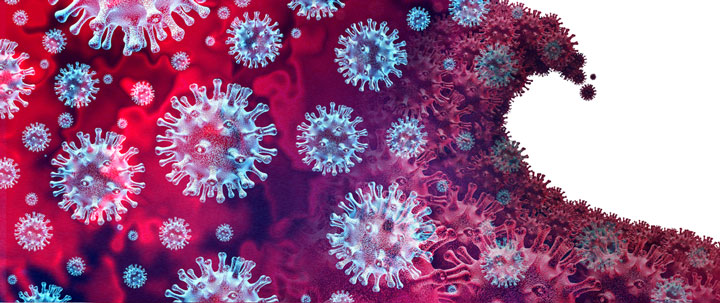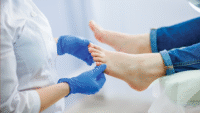Takeaways:
- Develop proactive surge planning approaches in advance of a crisis.
- Predictive modeling, such as, anticipating staffing needs, allows for a proactive structure to resource capability and bed capacity so that teams can quickly implement plans based on triggers.
- Taking a systemized approach to safe care delivery allows teams to use fundamental safety tools to guide them through any disaster.
Training, redeployment, and bed-capacity expansion factored into this hospital’s approach.
Editor’s note: This is an early release of a web exclusive article for the February 2021 issue of American Nurse Journal.
As soon as Piedmont Fayette Hospital (a 282-bed community hospital) received its first patient with COVID-19, leadership (including nursing, anesthesia, respiratory, and clinical education) began planning how to best protect staff and ensure continued safe compassionate care. Elective surgeries and most outpatient departments were closed to make room for patients with COVID-19 and to preserve personal protective equipment (PPE). Nursing leaders also saw a need for education, an emergent staffing plan, and critical care bed expansion. The Incident Command Center, at the system and hospital levels, was central to communication and creating the proper processes, procedures, and best practices.
Providing education
Education began with proper PPE donning and doffing, following current Centers for Disease Control and Prevention and Piedmont Healthcare guidelines, with input from infectious disease physicians. The hospital’s infection preventionist nurse and nursing clinical education coordinator created donning and doffing instructions that were placed in COVID-19 rooms so they could be easily viewed. (See Reinforced education.)
Reinforced education
Piedmont Fayette Hospital’s infection preventionist nurse and nursing clinical education coordinator created signage to reinforce proper personal protective equipment donning and doffing, as well as enhanced respiratory and contact precautions. The signs were placed on the doors of all patients with COVID-19 as reminders of what staff had been taught.
Because the operating room (OR) was no longer performing elective surgeries, OR nurses volunteered to round each day to teach and monitor proper donning and doffing. The infection preventionist nurse taught OR staff how to complete isolation surveillance, which included a checklist for COVID-19 patients. On the rounds, OR nurses monitored correct PPE use, ensured correct signage was placed on patients’ doors, and provided real-time PPE guideline updates. This boots-on-the-ground approach allowed bedside staff to voice concerns or issues, which were either answered by the rounding nurses or escalated to the incident command center for quick resolution.
The staff peer-checked and peer-coached each other in real-time and asked clarifying questions as needed to ensure they were keeping themselves and their patients safe. Although this was an uncertain time for our nursing staff, they embraced the opportunity to help in an area that was outside their specialty. The nursing team realized that everyone has a role, regardless of specialization, to minimize the impending surge’s impact.
The hospital’s clinical education coordinator spearheaded the development of electronic health record (EHR) training for nurses from closed or other areas of the hospital. Although the training was brief, it gave nurses the confidence to review patients’ charts and, at a minimum, assist intensive care unit (ICU) nurses with assessments charting. We learned from PPE and isolation surveillance rounding that keeping the same nurses in the same roles allowed them to increase their competence over time. We extended this approach when nurses from surgical services assisted in critical care, acute care, and call centers. Nurses also were offered work in nonclinical areas, including environmental services, dining and nutrition, and hospital entrance screening.
Identifying staffing resources
Planning for the anticipated patient surge included identifying available nurses not in direct patient care and determining how to best use their skills. The human resources department pulled a list of all nurses employed at the hospital to find those with recent or past critical or acute care experience. With this information, we devised a systematic approach to identify nurses who had the potential to assist in critical care, acute care, or in ancillary personnel roles.
Nurses’ previous experience provides an innate baseline ability to provide safe and effective care to specific patient populations. Using this theory, criteria were developed to assign each nurse a level to determine in which areas of the hospital they might be best suited to assist, how they could be deployed, and what nursing tasks they could safely perform.
Nursing levels
- Level 1—Critical care
- postanesthesia care unit (PACU), intermediate care unit (IMCU), and endoscopy nurses
- nurses from other areas with previous ICU experience
- possibly paramedics and catheterization lab staff
- Level 2—Acute care
- any nurse with previous inpatient experience
- nurses from the Family Care Center (FCC; mother-baby unit)
- Level 3—Assigned tasks
- nurses with no inpatient experience
- neonatal intensive care unit nurses
- surgical technologists
- Other Roles
- runners and rounders
- callers to update families
Deployment guidelines
Level 1 RN—ICU
- All PACU, IMCU, and endoscopy RNs; RNs from other areas with previous ICU experience; may include paramedics and catheterization lab staff.
- Paired with ICU nurse for delegated care
- Vital signs, intake and output, daily weights and immediately reporting abnormal values to ICU nurse
- Medication administration as delegated by ICU nurse
- Shared charting responsibilities with ICU nurse
- Chlorhexidine gluconate baths
- Central line care
- I.V. insertion
- Blood administration
- Lab collections
- Dressing changes
- Patient repositioning
- Urinary catheter insertion
- Physical assessments and EHR documentation
- Other tasks for which the staff member has competency
Level 2 RN—Acute care
- Any nurse with previous inpatient experience and FCC nurses
- Complete and document assessments on assigned patients
- I.V. insertion
- Urinary catheter insertion
- Central line management
- Vital signs, intake and output, daily weights
- Medication administration
- Chlorhexidine gluconate baths
- Dressing changes
- Blood administration
- Ambulation
- Take discharged patients to lobby for pickup
- Other tasks for which the nurse has competency
Level 3 RN—Acute care ancillary staff
- Nurses with no inpatient experience. NICU nurses, surgical technologists
- Phone calls to update families on patients’ condition
- Vital signs on assigned patients; give to patient care technician for entry into the EHR
- Assist patients with activities of daily living (ADLs)
- Assist with baths and linen changes on assigned patients
- Distribute ice and blankets as needed
- Assist with patient mobility, repositioning, and getting patients into a chair when appropriate
- Point-of-care blood glucose testing
- Answer call lights
- Bladder scans (training required)
- Discard trash and linens from assigned rooms
- May work as a runners (gathering supplies, taking specimens to the lab)
- Take discharged patients to lobby for pickup
Other Roles: Clinical staff and runners, rounders, and surgical techs
- Deployable labor and delivery staff will go to FCC and FCC staff will go to acute care units in need:
- Complete and document assessments on assigned patients
- I. V. insertion
- Urinary catheter insertion
- Central line management
- Vital signs, intake and output, daily weights
- Medication administration
- Chlorhexidine gluconate baths
- Dressing changes
- Blood administration
- Get patients into chair when appropriate
- Take discharged patients to lobby for pickup
- Runners:
- Assigned to nurses caring for patients with COVID-19
- Remain near assigned nurse while they’re in patient’s room to gather supplies as needed
- Gather needed supplies as requested by the nursing staff
- Assist with linen and trash double bagging
- Wipe down countertops, door handles, hallway rails, and keyboards outside patient rooms every 2 to 3 hours
- Rounders:
- Gather equipment as requested
- Go to other departments for needed items
- Wipe down countertops, door handles, hallway rails, and keyboards outside patient rooms every 2 to 3 hours
- Be a resource for the staff when items are needed from other departments or items need to be sent to other departments
- Take discharged patients to lobby for pickup
- Surgical technologists:
- Urinary catheter insertion (training required)
- Central line maintenance (training required)
- Vital signs, intake and output, daily weights (just-in-time training as it’s needed at the bedside)
- Chlorhexidine gluconate baths (training required)
- Dressing changes
- Apply sequential compression device as needed
- Take discharged patients to lobby for pickup
- Assist patients with ADLs
- Assist with baths and linen changes on assigned patients
- Distribute ice and blankets as needed
- Assist with patient mobility, repositioning, and getting patients into a chair when appropriate
- Answer call lights
- Perform bladder scans if oriented to process (training required)
- Discard trash and linens from assigned rooms
- May work as a runner/rounder
Assignments and training priorities
Nurses in the closed areas of the hospital were contacted by phone and email and supplied with the list of levels. Each nurse was asked to identify the level at which they felt most comfortable. Their ultimate assignment was based on their input and where they felt they would best fit.
Training and education priorities were determined based on nurses’ core responsibilities and their assigned levels. For example, Level 1 and 2 nurses received critical or acute care education relevant to their potential roles. Surgical technicians received training in urinary catheter insertion, central line maintenance, chlorhexidine gluconate baths, daily intake and output, daily weights, and bladder scans. In-person EHR classes, which were limited to 10 staff members each, were held several times daily to bridge the system’s functionality gaps between service lines. The classes covered topics such as, how to set up your view, scan meds, and assign patients, as well as efficiency tips.
Training was followed by clinical time on the appropriate unit so nurses could acclimate to the unit and refresh their nursing skills. In accordance with the lessons learned from PPE and isolation surveillance rounds, we strived for consistent assignments to ensure nurses were sent to the same unit.
All staff were empowered to voice concerns about their redeployment area. For example, an individual may have been assigned as a Level 1 or 2 nurse, but personal factors limited their ability to serve in those roles. In that case, they were deployed to a nonclinical area.
Because no visitors were allowed, one of the main roles for nonclinical nurses was to call patients’ families and share updates. The nursing staff asked if an email could be created for visitors or families to write to patients. PFHfeelthelove.com was created, and the emails were delivered and read to patients.
ICU expansion and tiered staffing
As resources were identified and education was in progress, critical bed availability became limited, requiring the hospital to adopt a model that would make the best use of available resources and create more ICU beds. The hospital began by expanding its ICU-bed capacity from 14 to 30 by converting the 30-bed IMCU into all ICU beds. Next, the PACU was converted into another ICU area with 20 beds capable of taking patients who needed ventilators. The surgical team, including anesthesiology, worked together to see how the plan could be implemented. After nurse leaders reviewed models through a literature search, the hospital adopted an ICU tiered staffing model. (See Surge tiered staffing model.)
Surge tiered staffing model
Piedmont Fayette Hospital adopted an intensive care unit (ICU) tiered staffing model to manage the surge of patients with COVID-19. By taking over the current ICU, intermediate care unit (IMCU), and post-anesthesia care units (PACU), the model allowed the hospital to expand to 64 ICU beds. In addition to ICU nurses, the team was staffed with PACU, IMCU, and endoscopy nurses.
APP = advanced practice provider, CHG = chlorhexidine gluconate, I&Os = intake and output, RASS = Richmond Agitation and Sedation Scale, RT = respiratory therapist, VS = vital signs
Tiered staffing allowed us to potentially care for 64 ICU patients in the expanded unit (ICU, IMCU, and PACU). A proposed staffing schedule created 2 weeks in advance of the expected surge included all nondirect care and leveled nurses. Nurses were asked to volunteer for shifts in their chosen role.
Challenges
During trial runs of the model over several shifts, we encountered some challenges. ICU staff struggled with delegating to and trusting unfamiliar nurses. Debriefings with the ICU nurses and their non-ICU partners helped us make changes to encourage this type of team nursing.
We consistently assigned nurses to the same units, and we learned that nurses from the intermediate care area and nonbedside nurses with past critical care experience who volunteered to deploy to ICU made for the best non-ICU nurse partners. Although non-ICU nurses received EHR education, we found that they were most effective when assisting with basic patient care, essentially doing what comes naturally to all nurses.
Today, our ICU area continues to be staffed with nurses from other specialty departments who volunteer to float to that area when needed. Although the PACU was fully converted and ready for ICU use, it wasn’t needed during this time.
Lessons learned moving forward
We learned several lessons while creating and implementing our patient surge plan.
- Predictive modeling, such as, anticipating staffing needs, allows for a proactive structure to resource capability and bed capacity so that teams can quickly implement plans based on triggers. Asking nurses in advance if they can change their hours and commit to working a different schedule on a different unit for a “just in case surge” worked best for us. This meant we could take a strategic approach to what would otherwise be reactive crisis management.
- Using fundamental safety tools can’t be overemphasized and require purposeful integration into all response plans. For example, we follow Always Safe principles: Support the team, Ask questions, Focus on the task, and Effective communication every time. Taking a systemized approach to safe care delivery allows teams to use these tools to guide them through any disaster.
- It’s important to develop proactive surge planning approaches in advance of a crisis. This philosophy and the team’s actions were critical to successful redeployment of resources and equipment.
- Current nursing models are divided by specialty, but cross-training core staff across applicable specialties builds relationships and promotes interdepartmental teamwork. Most importantly, it ensures intrahospital staffing resources during times of need.
- Incident command training is essential for all leaders and will never be underestimated again or used just for drills. Instead, it has become a part of problem solving, business continuity, and business recovery.
- Communication remains the core strength of all teams, and rapid change management has become the second core competency necessary to navigate the challenges we faced and continue to face.
The authors work at Piedmont Fayette Hospital in Fayetteville, Georgia. Gloria F. Giordano is manager of nursing programs, and Nicole J. Madrill is clinical education coordinator.
References
Centers for Disease Control and Prevention. Using personal protective equipment (PPE). August 19, 2020. cdc.gov/coronavirus/2019-ncov/hcp/index.html
Halpern NA, Tan KS. United States Resource Availability for COVID-19. Society of Critical Care Medicine. May 12, 2020. sccm.org/getattachment/Blog/March-2020/United-States-Resource-Availability-for-COVID-19/United-States-Resource-Availability-for-COVID-19.pdf?lang=en-US


















